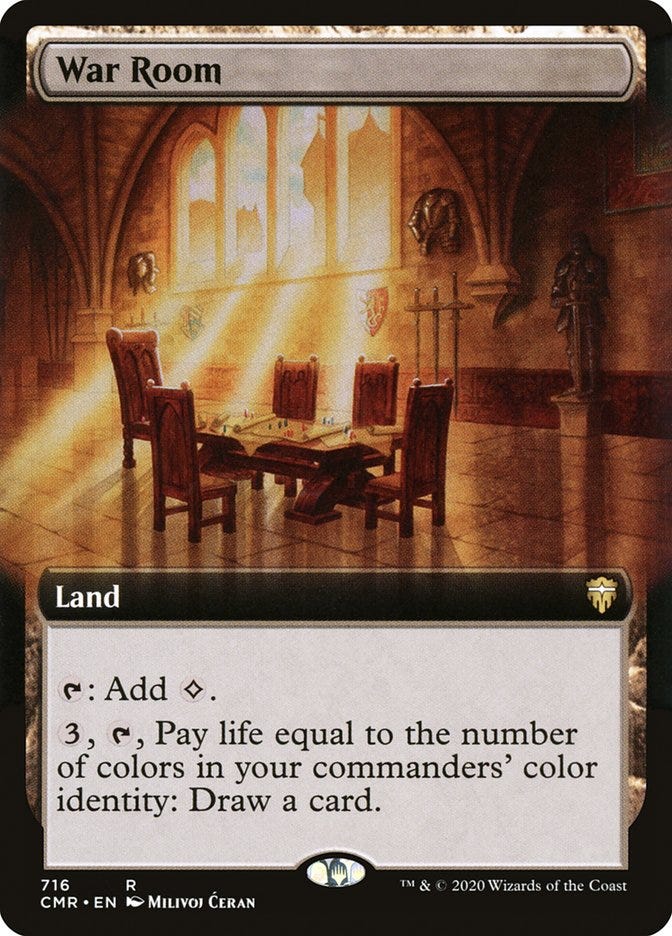Why I Don't Sort War Room as Card Draw
An Oddly Specific Gripe
Goodhart’s Law
In 1975, British economist Charles Goodhart criticized the government for a financial policy that conducted itself based on “targets” for broad and narrow money by saying “Any observed statistical regularity will tend to collapse once pressure is placed upon it for control purposes.” But this thought was thought to have a more broad and reaching application, and thus the following more generalized phrase became known as Goodhart’s Law:
When a measure becomes a target, it ceases to be a good measure.
An example of this law applied is often thought to be standardized testing in schools. At the time of introduction, standardized testing was felt to be a decent way to measure, in a comparable way, the efficacy of various schools at teaching fundamental skills. Whether this was true is up for question, but it became less accurate as time went on. Why? Because schools and teachers sought to make their schools look more effective by meeting that measure, and began teaching specifically for the test, prioritizing it over other potentially useful subject matter. When the measure (the test) became a target (what the teachers were teaching for), it became less effective at measuring the efficacy of the school in teaching valuable skills.
Another way to frame this law is that people will always play to the system they are in. Let’s take another example often used as an example that is famous for spurring the nickname “Cobra Effect.”
The Britsh ruled India for nearly 200 years, and during that time the territory of Delhi had a problem with venemous cobras. The British government got an idea
During the British rule of colonial India, the British government tried to reduce the number of venomous snakes in Delhi by offering a reward for every dead cobra. Almost immediately, people were turning in cobras left and right. The plan seemed to be working until citizens realized they could create their own income stream by breeding cobras. Once the government caught wind of this, the reward program was put to an end, leaving breeders with snakes that could no longer be exchanged for money. When these snakes were set free, the cobra problem became even worse.
War Room
So you’ve probably put two and two together by now about what I’m getting at. We have a lot of formulas giving us a “target” to meet in terms of cards that produce certain effects. 10 card draw, 12 removal, 10 ramp, 4 archdemons, 10 blue cards that search for lands, 7 dwarves, and 9 of everything else. But if we’re trying to fit 10 card draw cards in a deck, and we use War Room as one of those slots, my hot-take-of-the-month is that you’re kinda missing the point.
The advantage of War Room is that its a land that you tap for mana… and sometimes (yes, sometimes) you’ll get some benefit out of tapping it to draw a card. Yes, it is a card that says “Draw a card.” on it. But how many games are you happy to slam down War Room, immediately tap 3 mana and it and pay 1 life, and draw a card? What percentage of your games are you expecting to use that second ability? What percentage of games are you expecting to have a turn where you effectively spend 4 mana and 1 life to draw one card?
For me at least, 90% of the time I play War Room, I want to play it as a land and tap it for mana to cast my spells the whole game. Maybe I’ll use that mana to cast a Night’s Whisper or some other spell, and certainly, I’ll use the card draw effect if I have the time - after all, that utility is why I’m running it. But it’s not something I’m aspiring to do.
If I’m trying to run 10 card draw as per the Command Zone template, 9 card draw as per 7x9, or whatever template I’m trying to meet… and I’m including War Room as one of those effects, I’m engineering games where I don’t have enough card draw and regularly am relying on War Room to draw cards, instead of using it to cast my spells.


